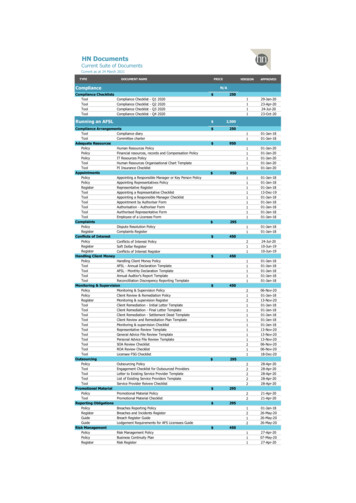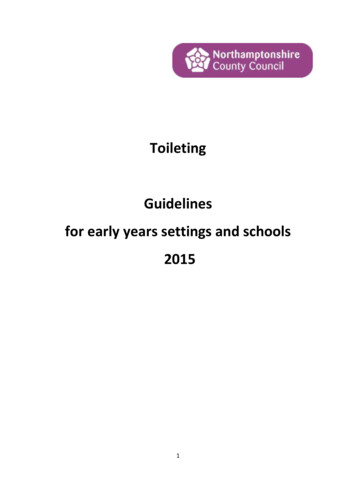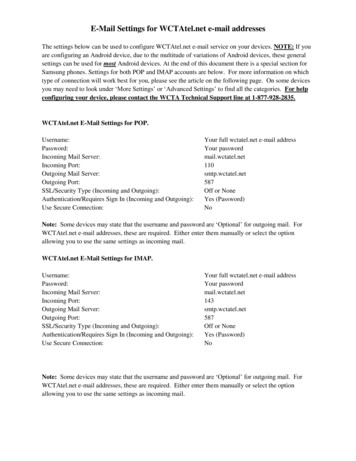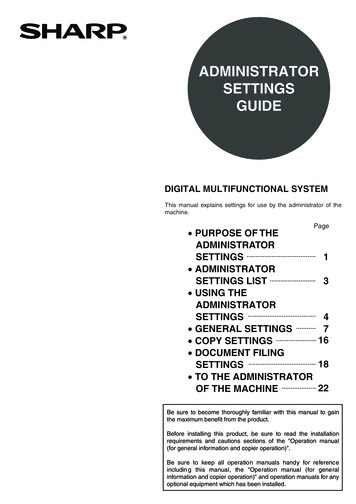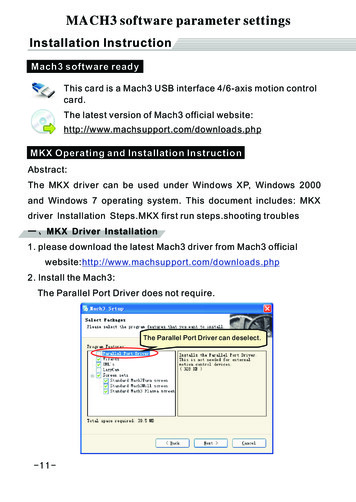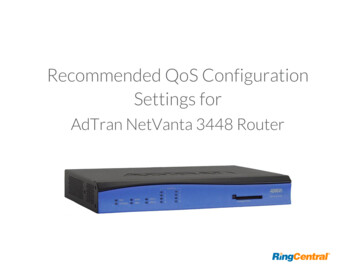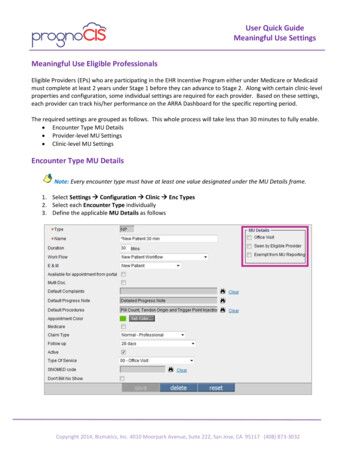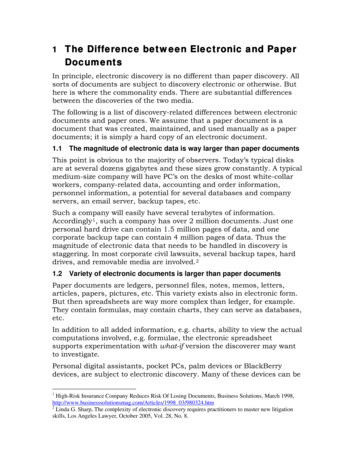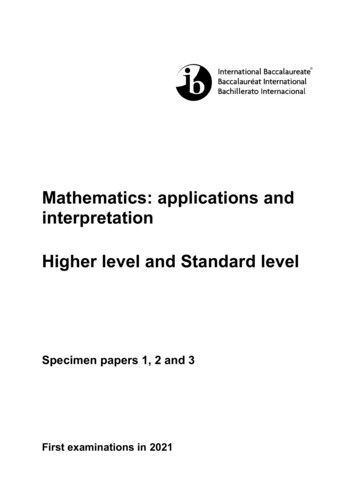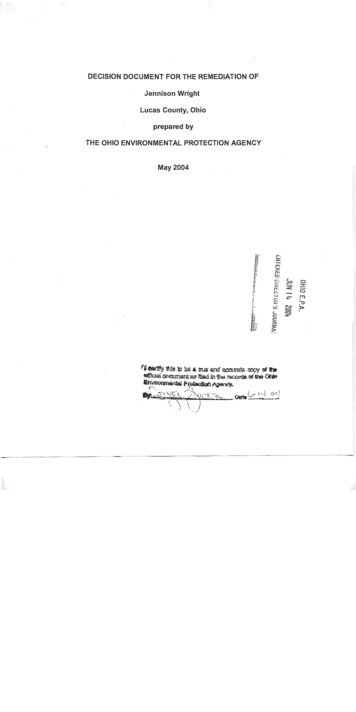
Transcription
DECLARATIONSITE NAME AND LOCATIONThe Jennison Wright Facility (the Site) is located in Lucas County, at 2332 BroadwayAvenue, in Toledo, Ohio (Site Location Map, Figure 1-1).STATEMENT OF BASIS AND PURPOSEThis Decision Document presents the selected remedial action for the Jennison Wrightfacility in Lucas County, Ohio, chosen in accordance with the policies of the OhioEnvironmental Protection Agency, statutes and regulations of the State of Ohio, and theNational Contingency Plan, 40 CFR Part 300.ASSESSMENT OF THE SITEActual and threatened releases of polynuclear aromatic hydrocarbons (PAHs), variouslight, non-aqueous phase liquids (LNAPLs) and various dense, non-aqueous phase liquids(DNAPLs) at the Site, if not addressed by implementing the remedial action selected in theDecision Document, constitute a substantial threat to public health or safety and arecausing or contributing to air or water pollution or soil contamination. The Site was thelocation of a wood treating facility from the early 1900s to 1990. While in operation, thefacility treated wood products, including railroad ties and flooring, using primarily creosoteand other coal tar materials. The plant also used coal tar to manufacture an asphaltpavement sealer known as Jennite.DESCRIPTION OF THE SELECTED REMEDYOhio EPA has selected, as its Preferred Alternative, remediation which encompasses threeelements. The elements are described in the Feasibility Study Report (dated January 3,2001) as Surface Soil Alternative SS-4, Shallow Ground Water Alternative SG-3, andBedrock Ground Water Alternative BG-3. Both ground water alternatives, as set forth inthe Preferred Plan dated April 4, 2003, have been slightly modified by Ohio EPA such thataggressive ground water monitoring during the early years of remedy implementation willbe conducted and play a role in any future decision to add additional wells and/or modifymonitoring schedules. Thus, additional well installation could exceed the number of wellsproposed in Alternatives SG-3 and BG-3.In addition, a use restriction agreement with limitations on the use of property and aprohibition against the use of ground water beneath the property will be implemented.Surface Soil Alternative SS-4 provides for a soil cover consisting of six inches of topsoilplaced over the areas to be addressed. The soil cover will serve to eliminate the incidentalingestion, dermal and inhalation hazards presented by dust and volatile constituents.2
TABLE OF CONTENTS1.0SITE BACKGROUND1.1Site History1.2Summary of the Remedial Investigation1.2.1 Soil Contamination1.2.2 Ground Water Contamination1.2.3 Interim or Removal Actions Taken to Date5578992.0SUMMARY OF SITE RISKS2.1Risks to Human Health2.2Risks to Ecological Receptors910103.0FEASIBILITY STUDY114.0REMEDIAL ACTION OBJECTIVES115.0SUMMARY OF REMEDIAL ALTERNATIVES5.1Soil Alternatives5.2Shallow Ground Water Alternatives5.3Bedrock Ground Water Alternatives131313146.0 COMPARISON AND EVALUATION OF ALTERNATIVES6.1Evaluation Criteria6.2Analyses of Evaluation Criteria6.2.1 Overall Protection of Human Health and the Environment6.2.2 Compliance with ARARs6.2.3 Long-Term Effectiveness and Permanence6.2.4 Reduction of Toxicity, Mobility or Volume Through Treatment6.2.5 Short-Term Effectiveness6.2.6 Implementability6.2.7 Cost6.2.8 Community Acceptance14141616161617171818187.0 SELECTED REMEDIAL ALTERNATIVE7.1Detailed Analysis of Surface Soil Alternaitve SS-47.2Detailed Analysis of Shallow Ground Water Alternaitve SG-37.3Detailed Analysis of Bedrock Ground Water Alternaitve BG-37.4Evaluation by Threshold, Balancing, and Modifying Criteria7.5Summary19198.0GLOSSARYAPPENDIX A2022232728RESPONSIVENESS SUMMARY430
DECISION SUMMARYJennison WrightLucas County, Ohio1.0 SITE BACKGROUND1.1 Site HistoryThe Jennison Wright Facility (the Site) is located in Lucas County, at 2332 BroadwayAvenue, in Toledo, Ohio (Site Location Map, Figure 1-1). The Site was the location of awood treating facility from the early 1900s to 1990. While in operation, the facility treatedwood products, including railroad ties and flooring, using primarily creosote and other coaltar materials. The plant also used coal tar to manufacture an asphalt pavement sealerknown as Jennite.Site Ownership and OperationThe Site is triangular in shape and occupies approximately 23 acres (Historical Site Layout,Figure 2-1). It is bordered on the south by Norfolk and Western Railway Company tracks,on the north and west by the Anthony Wayne Trail, and on the east by abandoned industrialbuildings and a residential neighborhood. Jennison Wright operated on the approximately23-acre Site via two separate leases from two railroad companies. One lease covered thewestern 16 acres of the Site, while the second lease covered the eastern 6 acres.Approximately 16 acres of the Site are owned by Norfolk & Western, who leased theproperty to Jennison Wright. Jennison Wright Corporation (Jennison Wright I) wasincorporated in 1910. The assets of Jennison Wright I were sold in 1981 to a newly formedcorporation called The Jennison Wright Corp. (Jennison Wright II). The name of JennisonWright I was changed to J.W. Liquidating Corporation after the sale of assets.In 1987, Ohio EPA and Jennison Wright II entered into a consent decree to perform aRemedial Investigation (RI) for the entire approximately 23-acre Site to address violationsof state hazardous waste and water pollution laws. A RI Report, prepared by WoodwardClyde Consultants, was submitted to the Agency in October 1988; however, Ohio EPAdisapproved the Report, listing specific deficiencies. Jennison Wright II filed Chapter 11bankruptcy on November 17, 1989.Some time after the Jennison Wright bankruptcy declaration of 1989, Norfolk and Westernmerged with Southern Railway, and became Norfolk Southern Railway Company. NorfolkSouthern (NS) is one of the settling parties under the current order.5
About six acres of the property were owned by Penn Central, leased to Jennison WrightI, and eventually sold to Jennison Wright II. Penn Central conveyed its liability toConsolidated Rail Corporation (Conrail) as a result of the Regional Railroad Reauthorization Act.An Administrative Order on Consent was signed June 2, 1994 among the State of Ohio,Norfolk & Western Railway Company [later Norfolk Southern (NS)] and Conrail for aRemedial Investigation and Feasibility Study for the entire approximately 23-acre Site.Although Jennison Wright I, Jennison Wright II, and Penn Central were invited to participatein the agreement, they declined to enter into the consent agreement. Penn Centralindicated it would not participate in the consent order because of a pending court caseconcerning liability for environmental damage under the Regional Railroad ReauthorizationAct.An Interim Remedial Action (IRA) was undertaken at the Site between October 1994 andApril 1995 to remove all vessels, structures, drums, waste piles and residuals of creosotecontaminated soils for appropriate off-Site disposal. Approximately 6 million dollars wasexpended during this removal action by Norfolk & Western and Conrail.On August 15, 1995, the Findings & Orders were amended to add American PremierUnderwriters, Inc. (formerly Penn Central).According to Lucas County Auditor records, Mr. Ron Gorney acquired the 6 acres that hadbeen owned by Jennison Wright II, as forfeited land, on June 2, 1998.Disposal HistoryThe Site was the location of a wood treating facility from the early 1900s to 1990, when thefacility was closed. While in operation, the facility treated wood products, including railroadties and flooring, using primarily creosote and other coal tar materials. The plant also usedcoal tar to manufacture an asphalt pavement sealer.The types of contaminants typically found in association with creosote and coal taroperations include polynuclear aromatic hydrocarbons (PAHs), various light, non-aqueousphase liquids (LNAPLs) and various dense, non-aqueous phase liquids (DNAPLs).A disposal pit, designated Disposal Area #1, was located in the northern corner of thefacility. The pit was covered with soil and other materials sometime prior to 1981. Also inthe northern end of the facility, a pit or tank containing creosote and/or coal tar was usedfor storage while creosote was manufactured from coal tar on-Site. This process wasdiscontinued in 1969. A building used for the production of creosote from coal tar wasformerly located at the north end of the facility. At an unknown date, a fire at this locationburned a former dock. Another fire occurred at the southwest corner of the Site in October1983.6
Past InvestigationsOn February 4, 1987, the Jennison Wright Corporation and the State of Ohio entered intoa Consent Order requiring the Company to conduct a Remedial Investigation/FeasibilityStudy (RI/FS). The RI reached the following conclusions: organic constituents were foundin the upper four feet of soil over much of the Site centered in areas where plant processeswere conducted; PAHs were found to extend to the soil/bedrock interface in one area; anda black, tar-like substance was found in voids in the rock at three boring locations. Theresults of the ground water investigation indicated that shallow and bedrock ground waterexist under the Site. Constituents associated with plant operations were found in samplesfrom four shallow and two deep wells at the Site. The RI was not completed until theparties entered into a second Consent Order a few years later.The Consent Order signed by Ohio EPA, Norfolk and Western, and Conrail in 1994included a requirement to perform an Interim Remedial Action (IRA). The IRA work beganin October 1994 and concluded in March 1995. The objectives of the IRA were to reduceexposure to risks associated with residues, reduce physical risks associated with remainingstructures and debris, reduce the risk of fire and remove surface obstructions which mightinterfere with completion of the RI at the Site.Wastes removed from the Site during the IRA included 39,500 tons of tar-impacted soil,885 tons of tar and sludge from tanks, 129,118 gallons of water and 2,100 tons of debris.Approximately 460 tons of steel were decontaminated and recycled, and 3,350 tons ofconcrete debris were removed, decontaminated, crushed, and used to backfill excavations.Asbestos was removed from three tanks and disposed off-Site.1.2 Summary of the Remedial InvestigationThe Remedial Investigation Report (RETEC, 1997) and Remedial Investigation ReportAddendum I (RETEC, 1998) present the results of the RI performed at the Site betweenApril 1996 and March 1998. The RI was structured to gather information required toachieve three goals: prepare a Site model which accurately describes existing conditions at the Site withan emphasis on hydrologic conditions, Site stratigraphy, sources of constituents,and the fate and transport of chemicals of interest; collect data on chemicals of interest in soil and ground water adequate to allowpreparation of baseline human and environmental risk assessments; and collect Site physical and chemical data adequate to allow the preliminary evaluationof the feasibility of implementing potential remedial technologies.Soil and ground water sampling was conducted as part of the RI. Results, relevant to theFS, are summarized below.7
The Remedial Investigation was conducted by Norfolk Southern Railway Company (Norfolk& Western Railway Company), Consolidated Rail Corporation (Conrail) and AmericanPremiere Underwriters (formerly Penn Central) and included a number of tasks to identifythe nature and extent of Site-related chemical contaminants. The remedial investigationwas conducted with oversight by Ohio EPA and was approved on December 30, 1999. Thetasks included sampling of soil and ground water. The data obtained from the investigationwere used to conduct a baseline risk assessment and to determine the need to evaluateremedial alternatives. This Decision Document contains only a brief summary of thefindings of the Remedial Investigation and Feasibility Study (FS). Please refer to theRemedial Investigation Report (RI) and FS Report for additional information on contaminantconcentrations.The nature and extent of contamination at the Jennison Wright facility in eachenvironmental medium and the contaminants of concern attributable to the Site aredescribed below.1.2.1 Soil ContaminationSurface Soil ContaminationTwenty-one (21) surface soil samples were collected during the RI fromdepths of 0 to 0.5 feet below grade. Samples were collected across the Sitein areas that were excavated and backfilled during the IRA and in areas thatwere left undisturbed. Polynuclear Aromatic Hydrocarbons (PAHs) andcarcinogenic PAHs were detected in 19 of the 21 surface soil samplesanalyzed during the RI. Detected total PAH concentrations ranged from 0.39to 6,131 mg/kg (milligrams per kilogram), and total carcinogenic PAHconcentrations ranged from 0.247 to 3,706 mg/kg.The highestconcentrations of PAHs and carcinogenic PAHs were detected in samplesfrom the central and eastern areas of the Site that were not excavated duringthe IRA.Subsurface Soil ContaminationTwenty-one (21) subsurface soil samples were collected in the samelocations as the surface soil samples from depths of 0.5 to 1.5 feet belowgrade. Detected total PAH concentrations ranged from 0.13 to 753.1 mg/kg,and total carcinogenic PAH concentrations ranged from 0.082 to 392 mg/kg.The highest total PAH concentration was detected in the center of the Site,immediately outside of the IRA excavated area. Other total PAHconcentrations above 200 mg/kg were detected in the center of the Sitewithin the excavated area and in the southwest corner of the Site.8
1.2.2 Ground Water ContaminationShallow Ground Water ContaminationGround water from 16 shallow monitoring wells was sampled and analyzedfor volatile organic compounds (VOCs), PAHs, and metals. Detectableconcentrations of PAHs were found in six of the 17 monitoring wells sampled.Naphthalene concentrations of 10,000 ug/l (micrograms per liter) and 6,800ug/l were detected in MW-10 and MW-19, respectively. Benzene wasdetected in MW-2, MW-10, and MW-19 at concentrations of 72 ug/l, 44 ug/l,and 26 ug/l, respectively. Arsenic and barium, which were detected in wellsacross the Site, are believed to be naturally occurring.Bedrock Ground Water ContaminationGround water samples from nine monitoring wells screened in the bedrockaquifer were analyzed for PAHs, VOCs, and metals.Detectableconcentrations of PAHs were found in five of the nine bedrock monitoringwells in the northern and eastern areas of the Site.After evaluation of data from the Remedial Investigation, separate lists ofConstituents of Interest (COI) for soil and ground water were developed. The COIidentified for surface and subsurface soil include priority pollutant PAHs,1-methylnaphthalene, 2-methylnaphthalene, arsenic, barium, chromium, andmercury. COI identified for shallow and bedrock ground water include benzene,ethylbenzene, toluene, xylene, arsenic, barium, and all 16 PAHs exceptacenaphthylene and benzo (g,h,i) perylene.1.2.3 Interim or Removal Actions Taken to DateThe Consent Order signed by Ohio EPA, Norfolk and Western, and Conrail in 1994included a requirement to perform an Interim Remedial Action (IRA). The IRA workbegan in October 1994 and concluded in March 1995. The objectives of the IRAwere to reduce exposure to risks associated with residues, reduce physical risksassociated with remaining structures and debris, reduce the risk of fire and removesurface obstructions which might interfere with completion of the RI at the Site.Wastes removed from the Site during the IRA included 39,500 tons of tar-impactedsoil, 885 tons of tar and sludge from tanks, 129,118 gallons of water and 2,100 tonsof debris. Approximately 460 tons of steel were decontaminated and recycled, and3,350 tons of concrete debris were removed, decontaminated, crushed, and usedto backfill excavations. Asbestos was removed from three tanks and disposed offSite.2.0 SUMMARY OF SITE RISKSA baseline risk assessment was conducted to evaluate current and future risk to humanhealth and ecological receptors associated with contaminants present at the Site. Theresults demonstrate that the existing concentration of contaminants in environmental mediapose risks to human health at a level sufficient to trigger the need for remedial actions.9
2.1 Risks to Human HealthHuman Health Risk AssessmentThe relevant portions of the human health risk assessment are represented by tworemedial action objectives for protection of human health from contaminants at asite; “cancer risk” and “non-carcinogenic risk.” The risk assessment identifies anumber of potential on-Site and off-Site receptors to the on-Site soil and subjectsthese receptors to a screening process to identify those likely to be the mostexposed to contaminants from the Site. This screening identifies the followingreceptors as those likely to have the highest exposures. Local residents adjacent to the Site potentially exposed to dust or volatilesemitted from on-Site soil transported off-Site with the wind. Future on-Site excavation workers potentially exposed to subsurface soilthrough incidental ingestion, dermal contact and inhalation of dust orvolatilized constituents. Future on-Site industrial workers potentially exposed to surface soil throughincidental ingestion, dermal contact and inhalation of dust or volatilizedconstituents.These receptors were subjected to quantitative evaluation. Intake equationsconsistent with Ohio EPA and USEPA guidance were used to estimate exposure tothe receptors for each route of potential exposure evaluated.Non-carcinogenic risk captures health risks other than cancer. A score of 1.0 or lesson the “hazard index” is considered acceptable. For all receptors, the hazardindices at the Jennison Wright Site are below a risk value of 1.0. Therefore, any riskcurrently associated with non-cancer elements is within the acceptable risk range.For carcinogens, the cancer risk is unacceptable only with respect to futurecommercial or industrial workers. This cancer risk is estimated to be 3.8x10-4 ,which is greater than the upper limit of acceptable risk. USEPA and Ohio EPAconsider a risk range of 1x10-4 to 1x10-6 to be acceptable (indicating a potentialcancer occurrence of one in ten thousand persons to one in one million persons),with 1x10-6 as a point of departure. The score at the Jennison Wright Site calculatesa potential cancer occurrence of 3.8 persons in ten thousand, which is higher thanthe highest acceptable risk of 1.0 cancer per ten thousand persons.For ground water, the risk assessment conceptual Site model indicates there aretwo flow regimes; one through shallow unconsolidated deposits and one throughbedrock. Direct use of ground water does not occur on or near the Site and is notexpected to occur in the foreseeable future.2.2 Risks to Ecological ReceptorsEnvironmental Risk Assessment10
Because the Site is fenced and located in an urban area, large terrestrial receptors(e.g., deer) are not expected to be present on-Site. The Site is unlikely to providea suitable habitat for small terrestrial species. As a result, potential exposurepathways to terrestrial ecological receptors are considered incomplete and thereforenot a risk. Potential exposures to aquatic species in the Maumee River and LakeErie are also considered incomplete because constituent migration is not expectedto reach these water bodies.3.0 FEASIBILITY STUDYA Feasibility Study was conducted by Norfolk Southern, Conrail, and American PremierUnderwriters, in order to define and analyze appropriate remedial alternatives. That study,which was conducted with oversight by Ohio EPA, was approved on January 3, 2001. TheRemedial Investigation and Feasibility Study are the basis for the selection of Ohio EPA’spreferred remedial alternative.4.0 REMEDIAL ACTION OBJECTIVESAs part of the remedial inv
The plant also used coal tar to manufacture an asphalt pavement sealer known as Jennite. Site Ownership and Operation The Site is triangular in shape and occupies appr oximately 23 acres (Historical Site Layout, Figure 2-1). It is bordered on
